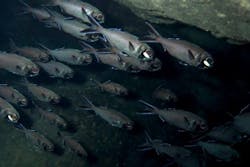Optogenetic stimulation determines behavior of flashlight fish
A team of researchers at Ruhr University Bochum (RUB; Germany) characterized new, unknown photoreceptors (opsins) from the bioluminescent flashlight fish Anomalops katoptron, allowing the fish to detect light with a specific wavelength. The opsin variants are specialized to detect low-intensity blue light in the wavelength range of bioluminescent light emitted by the fish, and can be used to influence the fish behavior via optogenetic stimulation.
Related: All-optical, high-precision functional optogenetics
The combination of these specific blue light receptors and light processing is an evolutionary adaptation to the ecological environment of the fish. The study is an interdisciplinary biological approach combining the expertise of geneticists Minou Nowrousian and Ulrich Kück, molecular biologist Melanie Mark, zoologists Jens Hellinger and Marcel Donner, as well as physiologist and optogeneticist Stefan Herlitze.
Besides the fact that bioluminescence is a widespread phenomenon in marine environments, it is currently not known how bioluminescence is processed and which physiological and behavioral consequences bioluminescence is evoking in most species. The flashlight fish Anomalops katoptron can be seen in shallow waters of coral reefs at moonless nights and is found during the day in caves up to 400 m deep. Light organs are situated under the eye, which produce blue light with a wavelength of 490 nm and are used to detect and hunt prey.
The research team analyzed the photoreceptor composition of the retina and found two visual pigments, which resemble the visual pigments expressed in the mammalian retina. Both of these photoreceptors are activated by low-intensity blue light in the range of 490 nm, which match the wavelength range of its own bioluminescent light.
Next, the research team analyzed if Anomalops katoptron uses blue light for behavioral responses. They performed a Pavlovian conditioning task with eight fish, where the fish had to associate feeding with a specific light pulse. "The fish were fed in darkness, but we used a strong red flashlight to illuminate the feeding area. We thought originally that the fish cannot see the red light, but found that they can associate the red light with food. Thus, once we switched on the red light at the corner of the aquarium, the fish swam into the light beam," Hellinger explains.
The scientists used this phenomenon to perform a behavioral test, to show that flashlight fish would react only to specific wavelength of light. They used a much lower light intensity in comparison to the red flashlight and found that the fish now only reacted to low-intensity blue light.
"The visual system of flashlight fish seems to be adapted to detect low-intensity light, such as star light or bioluminescent light, to adjust their own behavior," Herlitze concludes.
Full details of the work appear in the journal PLoS ONE.
